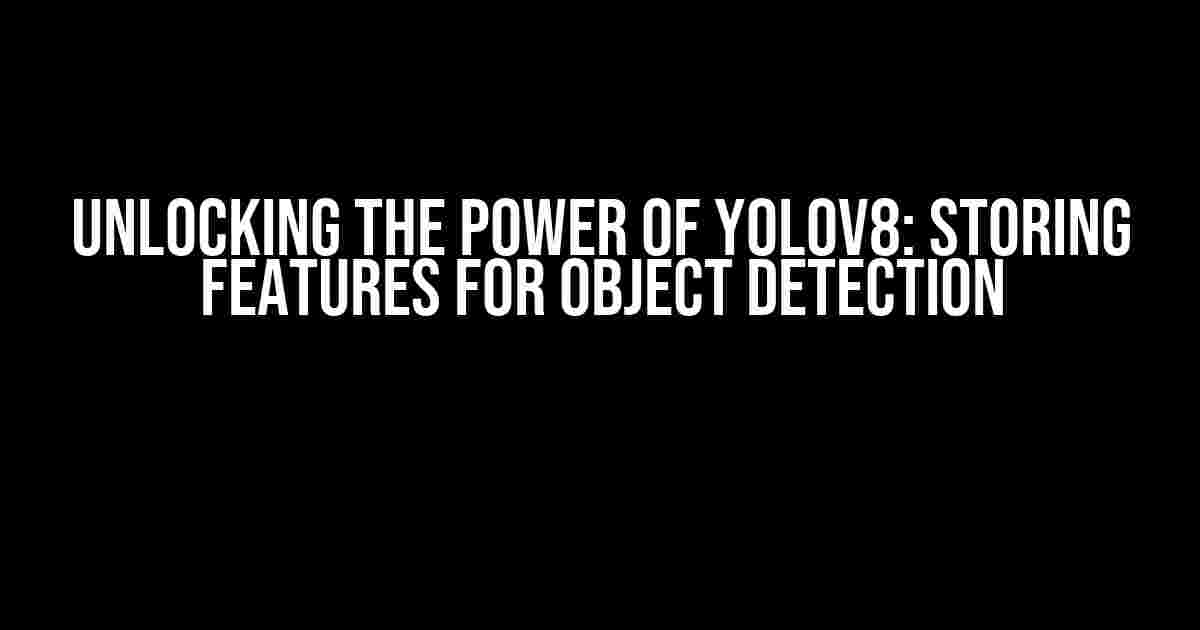As a machine learning enthusiast, you’re probably excited to dive into the world of object detection using the latest YOLOv8 model. But, have you ever wondered how to store the features generated by the model for the classifier to use during detection? Look no further! In this article, we’ll explore the ins and outs of feature storage for YOLOv8 object detection, providing you with a comprehensive guide to get you started.
What are Features in Object Detection?
In object detection, features refer to the characteristics or attributes of an object that help the model distinguish it from others. These features can be extracted from images, videos, or other data sources, and they play a crucial role in training and testing the model. The YOLOv8 model, in particular, generates features that the classifier uses to identify objects within an image.
Why Store Features?
Storing features is essential in object detection because it allows the model to:
- Reduce computational overhead by avoiding feature re-computation during inference
- Improve detection accuracy by leveraging stored features for future predictions
- Facilitate transfer learning and fine-tuning of pre-trained models
How to Store Features in YOLOv8
To store features in YOLOv8, you’ll need to modify the model’s architecture to include feature extraction and storage layers. Here’s a step-by-step guide to get you started:
Step 1: Modify the YOLOv8 Architecture
Start by modifying the YOLOv8 architecture to include a feature extraction layer. You can do this by adding a new layer after the convolutional neural network (CNN) backbone:
import torch
import torch.nn as nn
class YOLOv8(nn.Module):
def __init__(self):
super(YOLOv8, self).__init__()
self.backbone = nn.Sequential(
# CNN backbone layers
)
self.feature_extractor = nn.Sequential(
nn.Conv2d(128, 128, kernel_size=3),
nn.ReLU(),
nn.MaxPool2d(kernel_size=2)
)
self.classifier = nn.Sequential(
# Classifier layers
)
def forward(self, x):
x = self.backbone(x)
features = self.feature_extractor(x)
# Store features in a tensor or database
return features, x
Step 2: Implement Feature Storage
Next, you’ll need to implement feature storage using a tensor or a database. For this example, we’ll use a tensor to store the features:
import torch
features_tensor = torch.tensor([])
def store_features(features):
global features_tensor
features_tensor = torch.cat((features_tensor, features), dim=0)
# Call the store_features function after feature extraction
features, _ = model(x)
store_features(features)
Alternatively, you can use a database like SQLite or MongoDB to store features. This approach is particularly useful when dealing with large datasets or distributed systems.
Benefits of Storing Features in YOLOv8
Storing features in YOLOv8 offers several benefits, including:
| Benefit | Description |
|---|---|
| Improved Detection Accuracy | Stored features enable the model to leverage prior knowledge for better detection accuracy |
| Faster Inference | Avoiding feature re-computation during inference speeds up the detection process |
| Efficient Transfer Learning | Stored features facilitate transfer learning and fine-tuning of pre-trained models |
| Reduced Computational Overhead | Storing features reduces computational overhead during training and testing |
Challenges and Limitations
While storing features in YOLOv8 offers several benefits, it also comes with some challenges and limitations:
- Memory Constraints: Storing features can require significant memory, particularly for large datasets or high-resolution images.
- Feature Redundancy: Storing redundant features can lead to inefficiencies and reduced detection accuracy.
- Data Corruption: Feature storage is susceptible to data corruption, which can compromise detection accuracy.
- Scalability: Storing features can become challenging when dealing with distributed systems or large-scale datasets.
Best Practices for Feature Storage in YOLOv8
To overcome the challenges and limitations of feature storage in YOLOv8, follow these best practices:
- Use Efficient Storage Formats: Opt for efficient storage formats like binary files or compressed databases to reduce memory requirements.
- Implement Data Compression: Use techniques like feature pruning or dimensionality reduction to reduce feature redundancy and memory usage.
- Ensure Data Integrity: Implement data validation and integrity checks to prevent data corruption.
- Design Scalable Storage Solutions: Use distributed databases or cloud-based storage solutions to ensure scalability.
Conclusion
Storing features in YOLOv8 is a crucial step in object detection, enabling the model to leverage prior knowledge for better detection accuracy and faster inference. By following the steps outlined in this article, you can modify the YOLOv8 architecture to include feature extraction and storage layers, unlocking the full potential of this powerful object detection model. Remember to address the challenges and limitations of feature storage by implementing efficient storage formats, data compression, data integrity checks, and scalable storage solutions.
With this comprehensive guide, you’re ready to dive into the world of YOLOv8 object detection and unlock the power of stored features. Happy coding!
Frequently Asked Question
Get the inside scoop on storing features from YOLOv8 model for object detection!
What is the purpose of storing features from YOLOv8 model?
Storing features from the YOLOv8 model allows the classifier to utilize these features for object detection, enabling the model to learn and improve its detection capabilities. This is particularly useful when dealing with complex scenes or objects with varying sizes, orientations, and occlusions.
What type of features are generated by the YOLOv8 model?
The YOLOv8 model generates a set of feature maps, which are essentially a compact representation of the input image. These feature maps contain information about the object’s location, shape, size, and other relevant attributes that the classifier uses to make predictions.
How can I store these features efficiently?
One approach is to use a feature extractor, which can be implemented using a convolutional neural network (CNN). The CNN can be trained to extract relevant features from the input image, and these features can be stored in a compact format, such as a tensor or a matrix.
What are some common techniques for storing features?
Some common techniques for storing features include using feature pyramids, spatial pyramid pooling, and RoIAlign. These techniques enable the model to extract features at different scales and resolutions, making it more effective at detecting objects of varying sizes and orientations.
Can I use the stored features for other computer vision tasks?
Absolutely! The stored features can be used as input to other computer vision models, enabling them to perform tasks such as image segmentation, tracking, and recognition. This makes the stored features a valuable resource for a wide range of applications.


